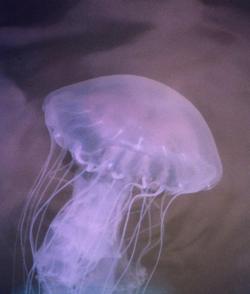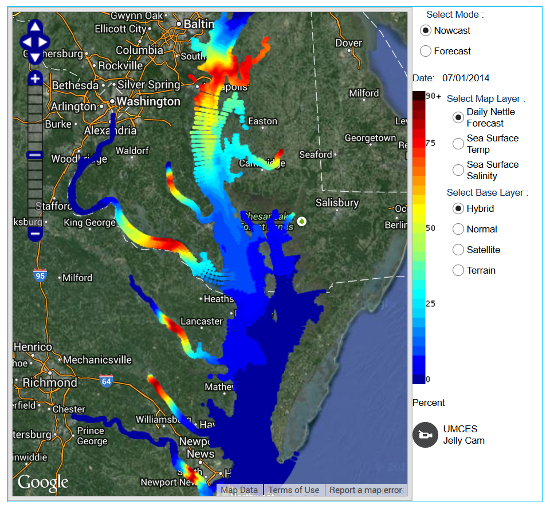 Jellyfish blooms influence plankton dynamics in coastal waters worldwide and can negatively impact tourism in the coastal eastern U.S.A., yet factors that affect bloom development and distribution are not well understood. We used the stinging sea nettle, Chrysaora quinquecirrha, as a model system to examine physical factors that control jellyfish populations in Chesapeake Bay. Chrysaora has the potential to control the flow of energy and nutrients through the food web due to its seasonally high abundance and its extremely high consumption rates. The impact of sea nettles on the Chesapeake ecosystem and economy might be better understood if their presence could be predicted. We developed a model that describes the preferred habitat of the medusan form of Chrysaora. This empirically-derived model predicts the probability of Chrysaora encounter as a function of sea-surface temperature and salinity. Our habitat model is applied to near-real time estimates of temperature and salinity derived from hydrodynamic models. This method allows “nowcasts” to be generated for the distribution and likelihood of Chrysaora occurrence in Chesapeake Bay by identifying locations where ambient conditions coincide with Chrysaora’s preferred habitat. Current predictions of our habitat model can be viewed here.
Jellyfish blooms influence plankton dynamics in coastal waters worldwide and can negatively impact tourism in the coastal eastern U.S.A., yet factors that affect bloom development and distribution are not well understood. We used the stinging sea nettle, Chrysaora quinquecirrha, as a model system to examine physical factors that control jellyfish populations in Chesapeake Bay. Chrysaora has the potential to control the flow of energy and nutrients through the food web due to its seasonally high abundance and its extremely high consumption rates. The impact of sea nettles on the Chesapeake ecosystem and economy might be better understood if their presence could be predicted. We developed a model that describes the preferred habitat of the medusan form of Chrysaora. This empirically-derived model predicts the probability of Chrysaora encounter as a function of sea-surface temperature and salinity. Our habitat model is applied to near-real time estimates of temperature and salinity derived from hydrodynamic models. This method allows “nowcasts” to be generated for the distribution and likelihood of Chrysaora occurrence in Chesapeake Bay by identifying locations where ambient conditions coincide with Chrysaora’s preferred habitat. Current predictions of our habitat model can be viewed here.
Collaborators: Christopher Brown (NOAA/NESDIS/ORA), Raleigh Hood (UMCES Horn Point Laboratory) and Jennifer Purcell (Shannon Point Marine Center)
Sponsor: NOAA’s National Centers for Coastal Ocean Science EcoForecasting Program
